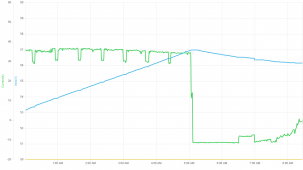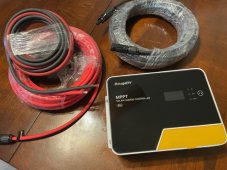The parts are starting to show up. I got the charge controller. It actually has a vey high quality look and feel. The die cast aluminum housing is well made and certainly has some mass to it. I powered it up off of my 3S battery and connected to the BlueTooth ap. Here are a few pictures.
View attachment 115834View attachment 115833View attachment 115832
I also got the red and black #10 awg 50 foot solar extension cables to get the panels up on the roof. And I got some #8 Windy Nation cable for the run to the battery bank, since it could hit 40 amps if I max this out. The last pic shows the #8 cable will easily fit in the cable clamps on the charge controller.
All of the MC-4 connectors I have here are from Bouge RV. I also got their crimper and MC-4 connector tools. I am a bit nervous about how lose the fit on the contact pins feels. The are very consistent, with no combination of pins feeling any looser. The one loose pair of pins that came with the 50 foot cables do fit a little tighter into each other, but is seems it is the female barrel is just a little smaller, the pin matches all the others. Since these panels are only 6 amps max each, I don't think these connectors will have any issues, even after the 2 parallel strings, I am only dealing with less than 12 amps. There is a lot of contact area in an MC4, but I just expected to need a bit more force to push the pins together. I guess I expected something like an XT-60 connector. These need far less force to push together.
And the "Y" cables just showed up. Their MC-4 connectors actually fit tighter, but I am a bit disappointer they are made with just 4 mm^2 wire instead of the 6 mm^2 wire I got for the home runs. But yes, it can take the current of 12 amps and it's only a foot of it.
The last thing to come will be the actual solar panels. They are now showing getting here tomorrow (Tuesday 10/11/22) by 10 pm.









